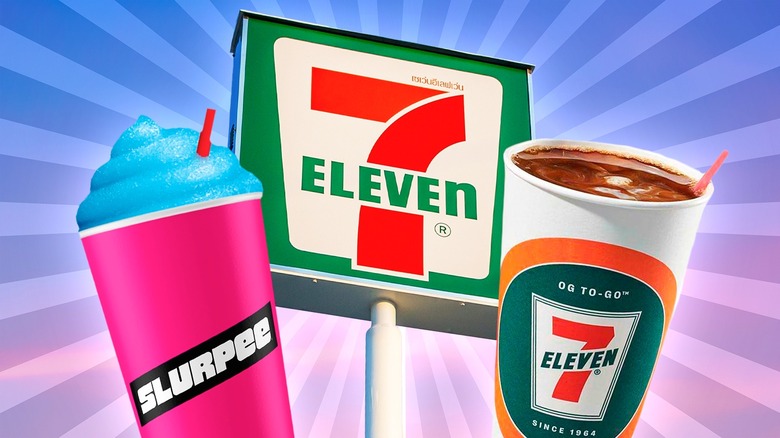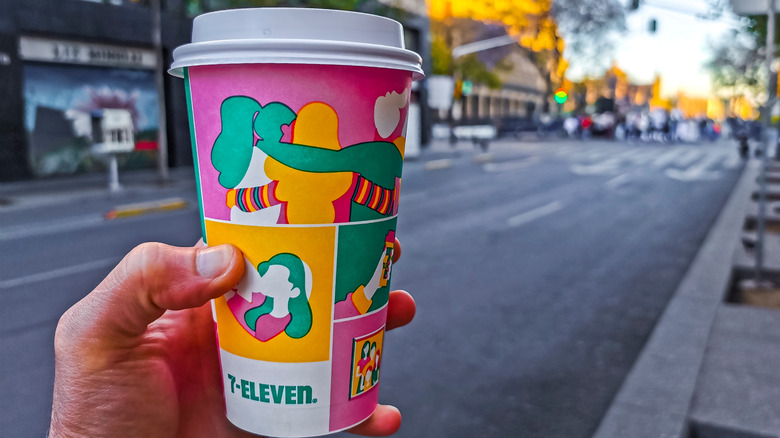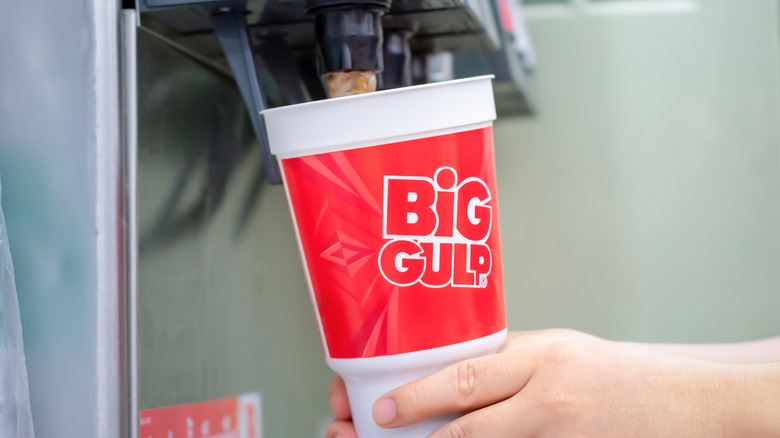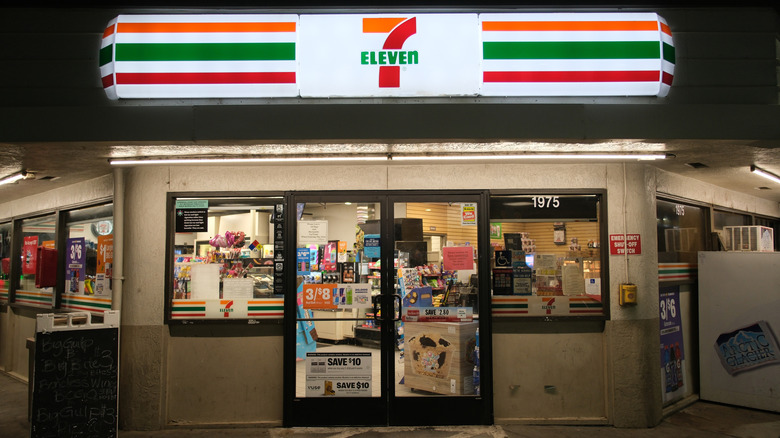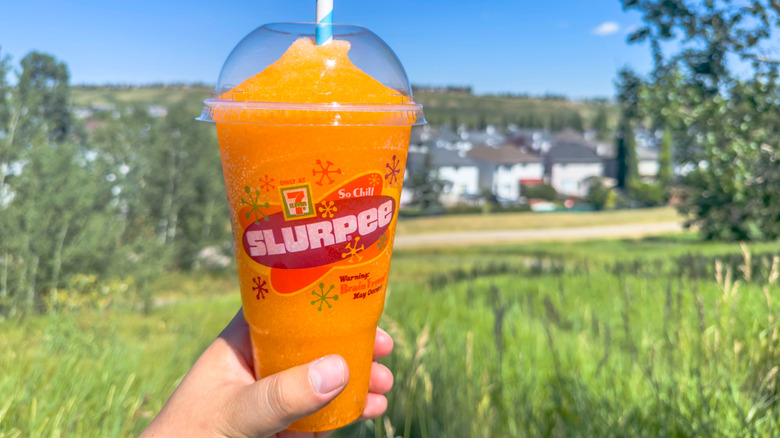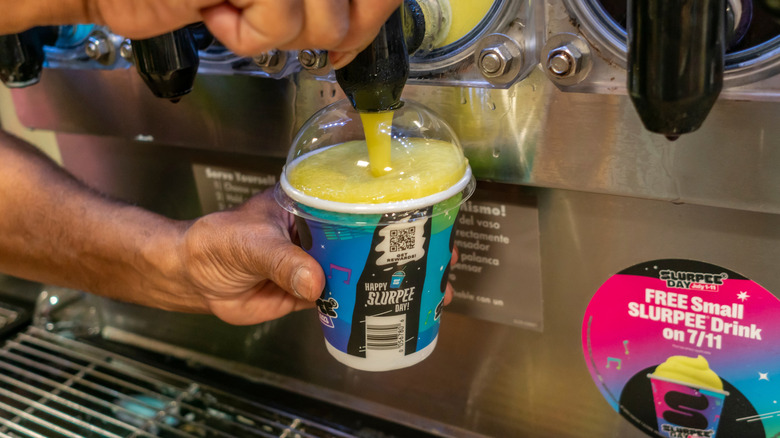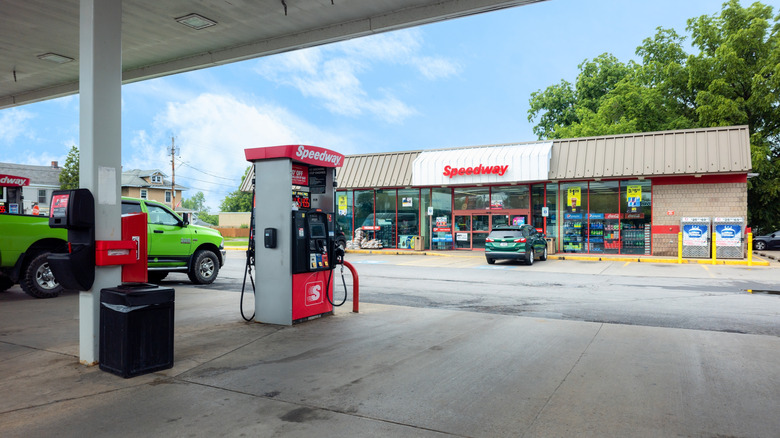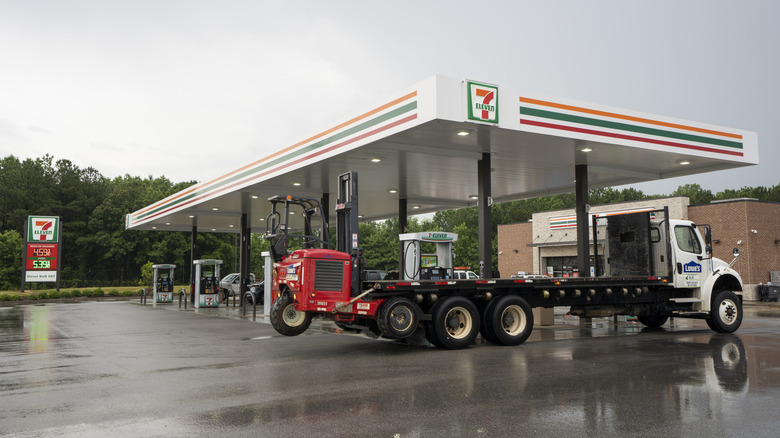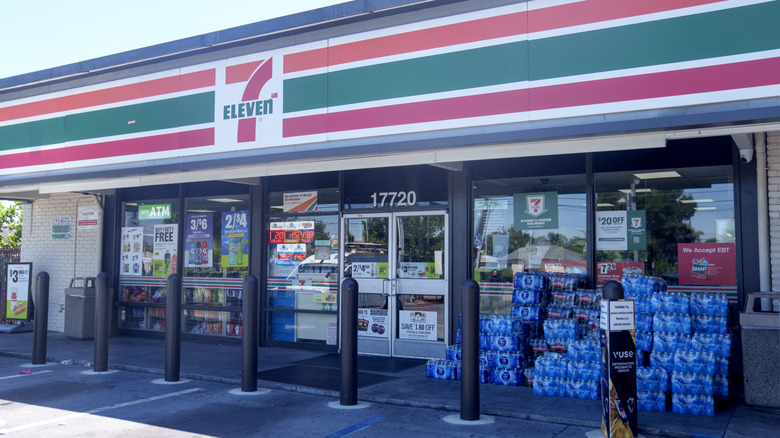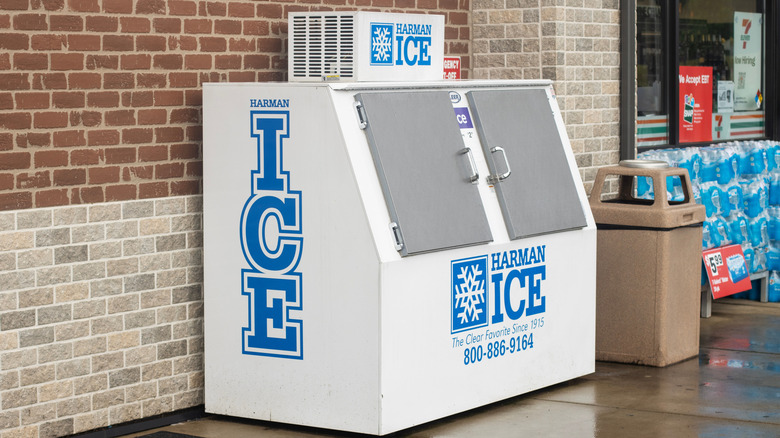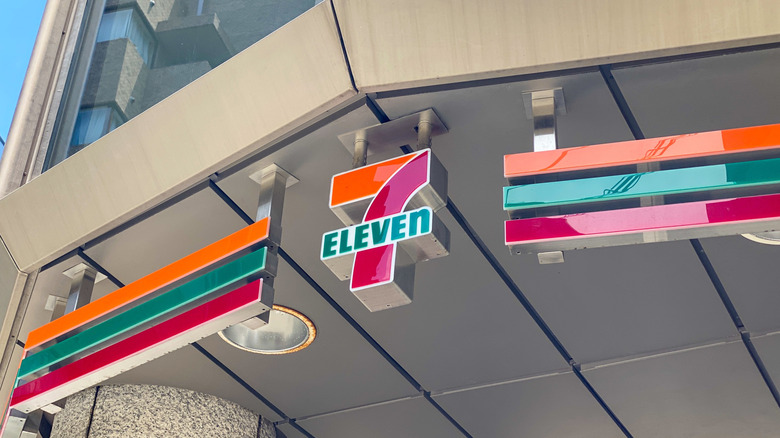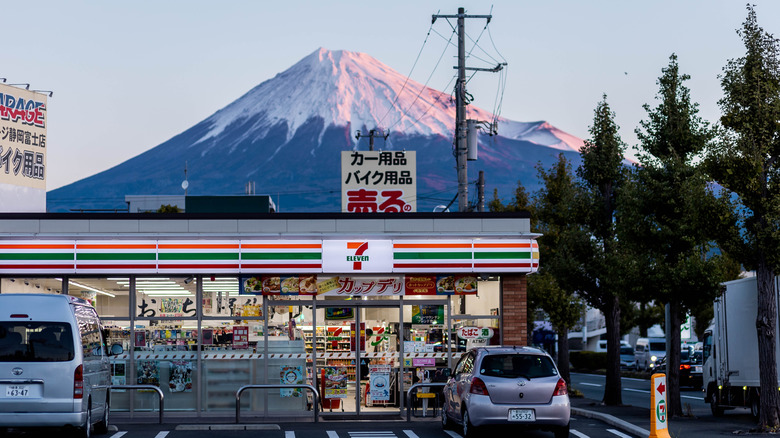Secrets Of 7-Eleven You'll Wish You Knew Sooner
Known for its massive soft drinks and 24/7 operation, 7-Eleven is a convenience store that will satisfy your snack fix any time, day or night. Where else can you fill up your gas tank, grab a bag of chips, pick up a sandwich for lunch, and wash it down with an icy Slurpee, all at once? It carries its own line of food items similar to what you'd find at other quick stops, such as hot dogs and chips, but it is best known for its self-service drink options.
What started as a simple icehouse in Texas expanded to include a few grocery items. Over the years, the offerings grew to include drinks, self-service gas pumps, and more. 7-Eleven even purchased other similar stores, bringing them all together under a parent company.
While the chain has had its share of ups and downs as it responded to customer demand and the economy, today, it has locations all around the globe. Here are some of the little-known secrets and fun facts about the chain.
7-Eleven offered the first to-go coffee cup
You can thank 7-Eleven for making to-go coffee cups part of your daily routine. While the history of coffee dates back to around the 15th century, with unverified references going back as far as 5 centuries before that, it wasn't until the 1960s that it was marketed as a beverage you could have as you went about your day. Before that, coffee was mostly served in mugs and cups that customers used in the restaurant or diner. They sat and stayed a while as they consumed the hot beverage, taking time to savor the brew. So when 7-Eleven realized that people wanted their cup of Joe without stopping their busy day, it launched a sales campaign to let customers know that they could order a cup and take it with them.
7-Eleven was the first convenience store to pack up coffee for customers on the go using disposable cups. Today, it seems like you can get a to-go cup of coffee just about anywhere, so clearly the convenience store was onto something that people wanted. 7-Eleven still keeps multiple varieties brewed and has a self-serve coffee station for customers to add extras to suit their taste (like sugar, sweetener, or cream).
The first self-serve soda fountain
7-Eleven was a pioneer of firsts, including the first self-serve soda fountain. Beginning in the 1970s, customers could pour their own soda over ice at the store and bring it up to the register. After filling the disposable drink cup with ice and soda (or lemonade or water), they pay based on the size of the cup. This allowed things to move faster in the store since no one had to wait for service. It also allowed the chain to cut down on labor costs, since they didn't need to staff a soda counter to dispense soft drinks.
While they offer multiple sizes for the soda machine, the iconic Big Gulp is what 7-Eleven is best known for bringing to the convenience store industry. This extra-large cup holds a whopping 32 ounces of soda, but it didn't come around until a few years after the self-service idea took off. Before the Big Gulp came around in the late 1970s, sodas came in 12- or 20-ounce sizes, which was pretty typical at the time. Customers could fill the cups themselves at the self-serve kiosk, but when they had the chance to get even more soda, things really started to pick up.
Before tossing your Big Gulp cup, check the bottom to see if it is recyclable. While not all disposable cups can be recycled, it's good to get into the habit of checking for that recognizable triangle symbol before heading for the trash.
The first 24/7 store catered to university students
7-Eleven has strong ties to Texas and can thank one of their stores in Austin for discovering just how popular a 24-hour store could be. The previous hours were 7 a.m. to 11 p.m., which meant 7-Elevens were open longer than most other stores when they first started selling convenience items in the 1920s. But fast-forward a few decades, and many other chains were also opening early and closing late as well.
In 1963, the Austin, Texas 7-Eleven realized that there were plenty of people in the community that needed a snack or drink nearby, even late at night. This single store decided to expand its hours to respond to customer demand. The initial expansion was just for one night and based on customers who were actively making purchases rather than a thought-out business decision. But it made the choice to stay open all night for local students, which ended up being a huge success.
This sparked the era of 24/7 convenience stores. The ability to provide snacks and drinks at any time of the day or night became something that set this chain apart from competitors. But other stores quickly caught on and started to do the same. In 2020, however, the COVID-19 pandemic and a shortage of employees led to challenges to staying open a full 24 hours. Eventually, though, many 7-Eleven stores were able to return to these hours in the years following.
Slurpees turn 60 years old in 2025
It's hard to think of 7-Eleven without envisioning a refreshingly cold and delicious Slurpee. But this icy version of a soda actually started at a Dairy Queen in 1958 when the owner accidentally left bottles of the sugary drink in the freezer for too long. His customers loved the half-frozen version, and he started to market them as ICEEs. He worked with an equipment manufacturer to come up with the technology to replicate the slushy consistency on a larger scale, and 7-Eleven was one of the purchasers of the machines in the 1960s.
The first Slurpee debuted at 7-Eleven in 1966 and became synonymous with the convenience store chain. The drink offered unique flavor combinations in fun and funky cups. The cup design has changed a little bit over the years but has always embraced vibrant colors and psychedelic swirls and patterns. Thanks to some really clever marketing aimed at younger customers, the store built up a following and demand for Slurpees that outpaced any other icy drink. 7-Eleven also partnered with other brands, including movies and TV shows, to build hype around both the release and the drinks. The iconic cups became collector's items, and 7-Eleven raked in the profits from a simple idea of icy soda. Today, there are new flavors debuted and limited releases to keep customers interested and coming for a drink. Classic favorites like Coca-Cola are always available as well, drawing in people looking for that piece of nostalgia.
You can get a free Slurpee on 7/11
Slurpees have always been a popular item in the 7-Eleven lineup, but the store decided to celebrate the iconic drink with special offers on its "birthday." What day did the company choose to mark the occasion? 7/11, of course!
Every July 11th, customers can get a drink on the house on Free Slurpee Day. This tradition began in 2002 and has grown to include limited edition flavors, special promotional cups, and viral social media shares. You can stop in to get a free small Slurpee at any 7-Eleven or Speedway store. Customers who are members of the chain's rewards program also get a coupon to use for another free Slurpee at a future date. There aren't any limits beyond the size, and customers can get any flavor that they want, including a combo option. Because Slurpees are self-service, customers can come up with their own creation or stick with one of the many flavors available at the store.
7-Eleven loves a good promotion, and added Bring-Your-Own-Cup day in April. Customers can bring in any container of their choosing — including motorcycle helmets, fish bowls, giant bowls, and anything else that is leak-proof and will fit under the fountain spout — and fill it with icy Slurpee for under $2.
7-Eleven owns Speedway and Stripes
With its success over the years, 7-Eleven looked to expand, and part of that plan included buying other convenience store chains. In 2021, the convenience store giant purchased Speedway, which had 3,800 stores at the time of the acquisition. By adding those stores to the existing 7-Elevens, the company had locations in 47 out of 50 states and around 16,000 individual locations. In the months following the purchase, 7-Eleven's parent company sold some of the Speedway stores, as well as a number of 7-Eleven locations, to other companies. A few years later, 7-Eleven purchased over 200 Stripes locations as well. As a leader in convenience stores from the beginning, it makes sense that 7-Eleven of today would want to bring these other successful brands under its wing.
The company still maintains plenty of locations under the 7-Eleven umbrella while keeping the original Speedway and Stripes names. While they don't offer the exact same fare, there are some favorites that you can find at all three stores. Speedway and Stripes offer Slurpees and Big Gulps, two of the most recognizable drinks started at 7-Eleven. You can even pick up your complimentary drink on Free Slurpee Day at Speedway or Stripes. Speedway and Stripes also have gas stations, like many 7-Elevens. All three are convenient spots to stop for a few essentials, fill up your tank, and get a snack or drink.
7-Eleven owns the convenience store and gas stations
Self-service is part of 7-Eleven's legacy, and another area that 7-Eleven decided to let customers access themselves was gas. The stations have included pump-your-own gas since 1928, when it was unusual for a station to do so. While not all 7-Elevens include gas pumps, those that do generally have self-service setups when allowed by local laws. Just like coffee and soft drinks, self-service gas was another area where 7-Eleven was an early adopter. As it saw success with this model, other gas stations and convenience stores followed. Today, self-service gas is both vastly more available than full-service only stations and preferred by most customers.
Some convenience stores have separate ownership from the on-site gas pumps, but the 7-Eleven corporate chain owns both at some of its locations. In some cases, the stores partner with outside fuel companies like ExxonMobile, Sunoco, or Chevron. Some 7-Eleven locations are franchises, which have a slightly different ownership structure from the corporate-owned locations. Around 8,000 7-Eleven locations have gas pumps where you can fill up your car, truck, or containers.
The name changed in 1946
7-Eleven has operated under a few different names since it began in 1927. Two local icehouses combined to form The Southland Ice Co. in the 1920s, and later started to sell fruit and other small items for convenience. The company used the blocks of ice to keep goods cold, and became popular because customers could get everything they needed at one stop. It began to sell grocery items, like bread, milk, and eggs, as well as ice. At the time, icehouses were open much earlier and stayed open later than grocers, so they were some of the only places customers could get these staples early in the morning or late at night.
To set themselves apart from other stores that sold ice and make the stores even more recognizable, these locations set up totem poles outside and operated under the name Tote'm Stores. Customers could come in and tote all of their items home without having to make other stops.
It wasn't until a couple of decades later that the store rebranded for good. In 1946, the name changed once more to reflect the hours of operation, which were 7 a.m. to 11 p.m. at the time. Opening under the name 7-Eleven, this marketing helped customers remember their hours and worked with catchy jingles and ad campaigns through the years. Even after the chain started staying open 24 hours, the 7-Eleven name stuck. It developed into the recognizable brand that it is today.
The first store just sold ice
Ice was a hot commodity in Texas in the 1920s as the main means of keeping perishable food cold and safe to eat. People stopped by icehouses to pick up blocks of ice, which they would take home and place in an icebox. As the ice melted, they would need to pick up new blocks. Consumers Ice, the predecessor to 7-Eleven, was an icehouse in Dallas operated by J.O. Jones and later by Joe C. Thompson Jr., who added fruit to their offerings. Customers loved that they could pick up a little something to eat along with their ice.
Consumers Ice was bought by Southland Ice Co. in 1927, and Thompson stayed to become the director of the new enterprise. Around this time, home refrigeration was also becoming more common, and it was only a matter of time before icehouses weren't necessary for keeping food cold. Johnny Jefferson Green, the operator of one of the icehouse locations, started selling eggs, milk, and cigarettes as well, thrilling customers who liked how easy it was to pick up a few groceries on their way home. The other stores adopted the same practices as well. Even though the first stores focused on selling ice, they eventually expanded to become the convenience stores that we know today. 7-Eleven still carries ice, most often found in refrigerated boxes outside of the store's entrance.
7-Eleven once filed for bankruptcy
7-Eleven saw great success from its start in 1927 through the following decades. It expanded from Texas to other states, added gas pumps, introduced iconic products like the Big Gulp and Slurpee, and saw overall growth. But business wasn't great in the '90s, which led to the chain filing for bankruptcy. At the time of the filing, 7-Eleven was $5 billion in debt and unable to make ends meet. The chain was bought out by a Japanese affiliate company that had already been in talks to purchase Southland Corp, the parent organization of 7-Eleven.
A lot of the problems came from increased competition as well as taking on additional debt over the years. The bankruptcy filing was very detailed and included a restructuring plan along with the acquisition by the Japanese company. 7-Eleven was able to make a comeback and improved to stay in business. Today, there are more 7-Eleven locations in Japan than in any other country.
There are more than 85,000 7-Elevens
There are more 7-Eleven stores than any other retailer in the entire world. There are over 85,000 stores in 19 countries worldwide, although this includes other stores under the 7-Eleven umbrella like Speedway and Stripes. Overall, there are more than 62,000 7-Eleven physical locations, including convenience stores as well as spots with both stores and gas stations.
There are actually more 7-Eleven stores in Japan, Thailand, and South Korea than there are in the United States, where the brand originated. This is likely due to the buyout of 7-Eleven's parent company in the 1990s by Japanese company Seven & i Holdings. In Japan, 7-Eleven sells egg salad sandwiches made with Kewpie mayo that are super popular, leading to the chain's reputation for deliciously tasty convenience food. Other favorites include more traditional Japanese dishes, such as onigiri and bento boxes. The shops are known for a great selection of prepared foods and snacks that tend to be fresher and more plentiful than their counterparts in the U.S.
